Unit 4 History and Traditions Reading and Thinking 课件(共27张PPT,内镶嵌视频)-2025-2026学年 人教版(2019)必修第二册
文档属性
| 名称 | Unit 4 History and Traditions Reading and Thinking 课件(共27张PPT,内镶嵌视频)-2025-2026学年 人教版(2019)必修第二册 |  | |
| 格式 | pptx | ||
| 文件大小 | 57.5MB | ||
| 资源类型 | 教案 | ||
| 版本资源 | 人教版(2019) | ||
| 科目 | 英语 | ||
| 更新时间 | 2025-06-17 21:44:51 | ||
图片预览

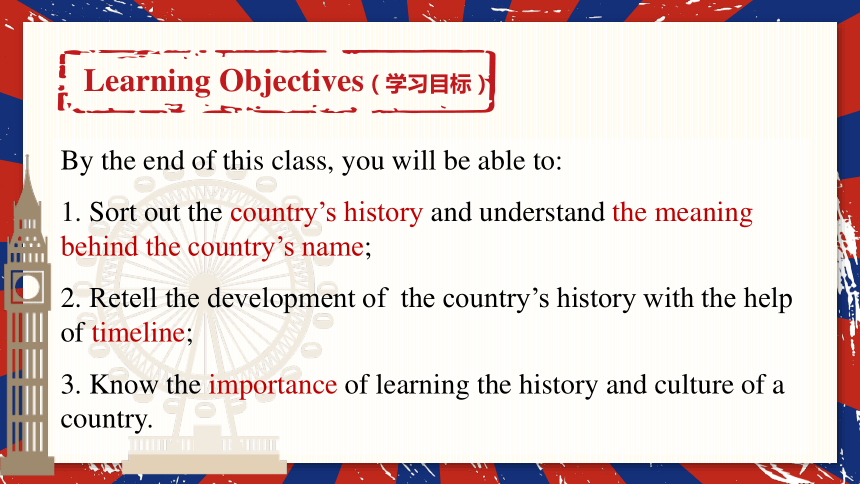
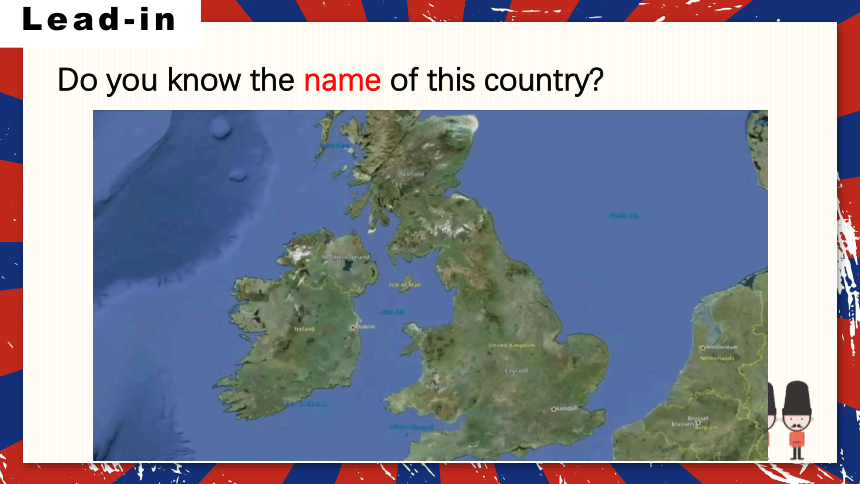
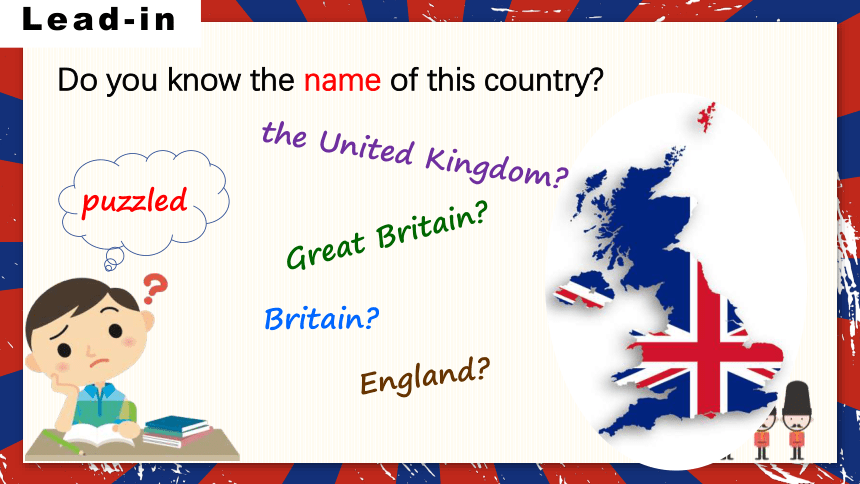
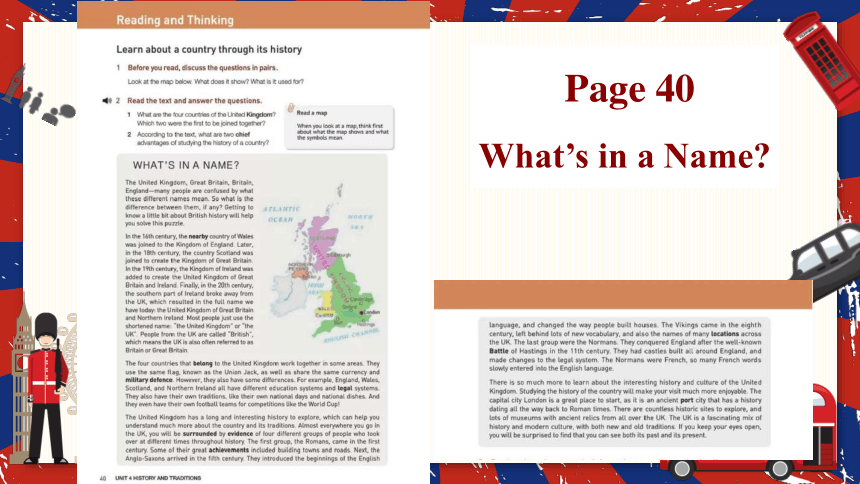
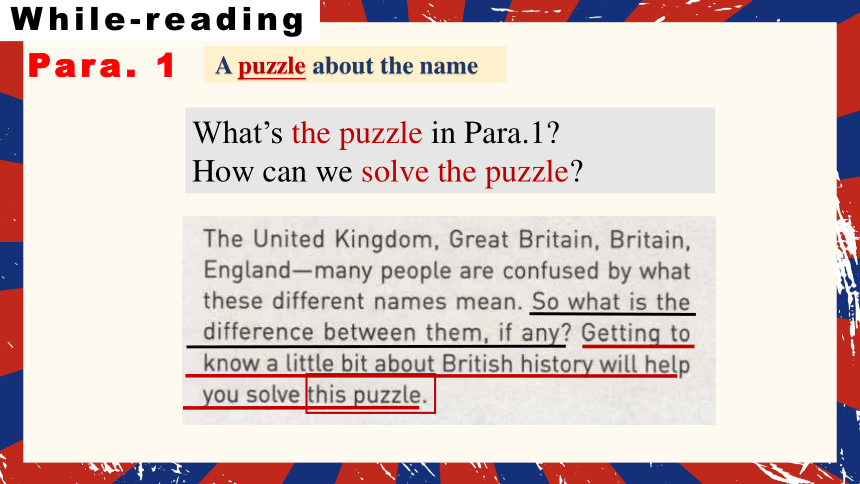

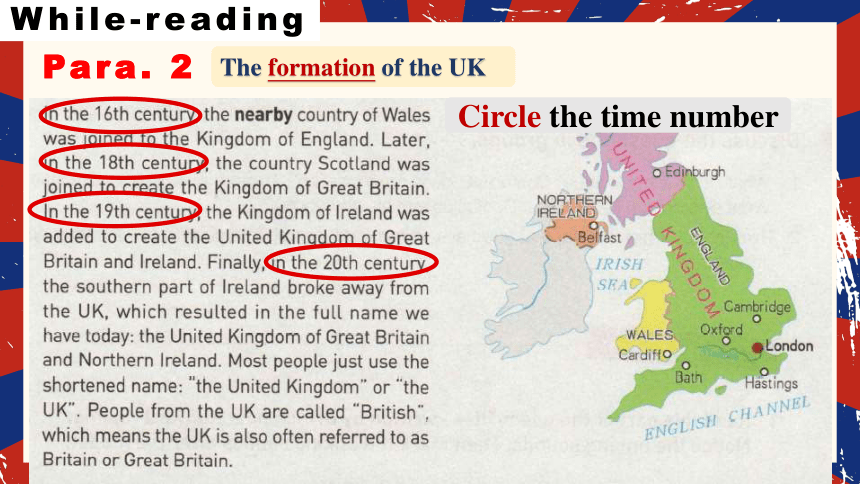
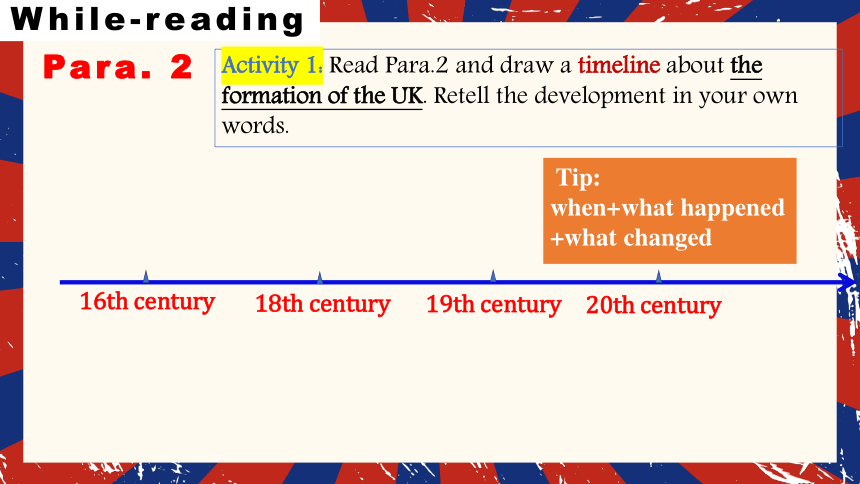
文档简介
(共27张PPT)
z
Book 2 Unit 4 Reading and Thinking
What’s in a Name
By the end of this class, you will be able to:
1. Sort out the country’s history and understand the meaning behind the country’s name;
2. Retell the development of the country’s history with the help of timeline;
3. Know the importance of learning the history and culture of a country.
Learning Objectives(学习目标)
Lead-in
Do you know the name of this country
Lead-in
Do you know the name of this country
Great Britain
the United Kingdom
England
Britain
puzzled
Page 40
What’s in a Name
While-reading
Para. 1
What’s the puzzle in Para.1
How can we solve the puzzle
A puzzle about the name
Para. 2
Prediction
In which order will Para.2 be organized
A. Space order
B. Time order
C. Logical order(逻辑顺序)
While-reading
What will be talked about in Para.2
The formation of the UK
Circle the time number
While-reading
Para. 2
Activity 1: Read Para.2 and draw a timeline about the formation of the UK. Retell the development in your own words.
Tip:
when+what happened +what changed
While-reading
Para. 2
16th century
18th century
19th century
20th century
16th century
18th century
19th century
20th century
the Kingdom
of England
the Kingdom
of Great Britain
the United
Kingdom of
Great Britain
and Ireland
the United
Kingdom of
Great Britain
and Northern
Ireland
the United
Kingdom
the UK
England
+Wales
England
+Wales
+Scotland
England+Wales
+Scotland+Ireland
England+Wales
+Scotland
+Northern Ireland
While-reading
Para. 2
when
what happened
what changed
(Name)
Activity 1: Read Para.2 and draw a timeline about the formation of the UK. Retell the development in your own words.
Para. 3
What similarities and differences do the four countries have
While-reading
Different capital cities
The similarities and differences among the four countries.
While-reading
Para. 3
Activity 2: Read Para.3 and find out the similarities and differences.
Similarities
Differences
Flag
(the Union Jack)
Currency
Military
defence
Education system
Legal system
Traditions
However
While-reading
National dishes
Football teams
National days
Relationship
Connected
but
Independent
Activity 2: Read Para.3 and find out the similarities and differences.
What are these four groups of people What are their evidences What does “took over” mean
Why is history so important Underline the reason.
While-reading
Para. 4
While-reading
Para. 4
Activity 3: Read Para.4 and draw a timeline about the four groups of people in UK’s history.
While-reading
Para. 4
Circle the time number
Activity 3: Read Para.4 and draw a timeline about the four groups of people in UK’s history. Retell the development in your own words.
1st century
5th century
8th century
11th century
While-reading
when
what happened
what changed
Romans arrived
built town and roads
Romans arrived
Anglo-Saxons came
Vikings came
Normans conquered England
Activity 3: Read Para.4 and draw a timeline about the four groups of people in UK’s history. Retell the development in your own words.
1st century
5th century
8th century
11th century
built town and roads
introduced English language;
changed the way people built houses
left behind lots of new vocabularies;
left the names of many locations
built castles
made changes to the legal system;
French words entered into English language
While-reading
when
what happened
what changed
While-reading
Para. 5
Why is history so important Underline the reason.
Why is London a great place to visit Underline the reasons.
While-reading
Para. 5
Who does the word “you” refer to
A. scientists B. visitors C. parents D. exchange students
What’s the writing purpose of writing this passage
A. to introduce the history of the UK for visitors
B. to share his travel experience with others
C. to tell us how to travel around the world
D. to show how travel can change the world
What’s in a name
Summary
a history
A people without the knowledge of their past history, origin and culture is like a tree without roots.
—Marcus Garvey
一个不了解自己历史、起源和文化的民族,就如同一棵无根之树.
In a name, there is _______________.
Discussion
Activity 4: Discuss with your group members:
If one of your foreign friends is going to visit China, you may advise him/her to learn Chinese history and culture in advance, why
I’d like to advise him/her to learn Chinese history and culture in advance, because_____________.
We should not only learn the knowledge of our past history and spread our culture, but respect other cultures and learn from each other.
Option 1
Your friend Li Hua is also puzzled about why the UK has so many different names and he is eager to know more about the history of the UK.
Please write a letter to him and share what you’ve learnt.
Your letter should include below information:
1. What does the United Kingdom consist of
2. What are the similarities and differences
3. What did four groups of people leave behind
4. Which city would you recommend to visit
Homework
Option 2
Learn about your city through its history and write an essay about it.
1. What’s in the name of your city
2. Do you know its previous names
3. Are there any tradition and culture in your city
Homework
T H A N K S
z
Book 2 Unit 4 Reading and Thinking
What’s in a Name
By the end of this class, you will be able to:
1. Sort out the country’s history and understand the meaning behind the country’s name;
2. Retell the development of the country’s history with the help of timeline;
3. Know the importance of learning the history and culture of a country.
Learning Objectives(学习目标)
Lead-in
Do you know the name of this country
Lead-in
Do you know the name of this country
Great Britain
the United Kingdom
England
Britain
puzzled
Page 40
What’s in a Name
While-reading
Para. 1
What’s the puzzle in Para.1
How can we solve the puzzle
A puzzle about the name
Para. 2
Prediction
In which order will Para.2 be organized
A. Space order
B. Time order
C. Logical order(逻辑顺序)
While-reading
What will be talked about in Para.2
The formation of the UK
Circle the time number
While-reading
Para. 2
Activity 1: Read Para.2 and draw a timeline about the formation of the UK. Retell the development in your own words.
Tip:
when+what happened +what changed
While-reading
Para. 2
16th century
18th century
19th century
20th century
16th century
18th century
19th century
20th century
the Kingdom
of England
the Kingdom
of Great Britain
the United
Kingdom of
Great Britain
and Ireland
the United
Kingdom of
Great Britain
and Northern
Ireland
the United
Kingdom
the UK
England
+Wales
England
+Wales
+Scotland
England+Wales
+Scotland+Ireland
England+Wales
+Scotland
+Northern Ireland
While-reading
Para. 2
when
what happened
what changed
(Name)
Activity 1: Read Para.2 and draw a timeline about the formation of the UK. Retell the development in your own words.
Para. 3
What similarities and differences do the four countries have
While-reading
Different capital cities
The similarities and differences among the four countries.
While-reading
Para. 3
Activity 2: Read Para.3 and find out the similarities and differences.
Similarities
Differences
Flag
(the Union Jack)
Currency
Military
defence
Education system
Legal system
Traditions
However
While-reading
National dishes
Football teams
National days
Relationship
Connected
but
Independent
Activity 2: Read Para.3 and find out the similarities and differences.
What are these four groups of people What are their evidences What does “took over” mean
Why is history so important Underline the reason.
While-reading
Para. 4
While-reading
Para. 4
Activity 3: Read Para.4 and draw a timeline about the four groups of people in UK’s history.
While-reading
Para. 4
Circle the time number
Activity 3: Read Para.4 and draw a timeline about the four groups of people in UK’s history. Retell the development in your own words.
1st century
5th century
8th century
11th century
While-reading
when
what happened
what changed
Romans arrived
built town and roads
Romans arrived
Anglo-Saxons came
Vikings came
Normans conquered England
Activity 3: Read Para.4 and draw a timeline about the four groups of people in UK’s history. Retell the development in your own words.
1st century
5th century
8th century
11th century
built town and roads
introduced English language;
changed the way people built houses
left behind lots of new vocabularies;
left the names of many locations
built castles
made changes to the legal system;
French words entered into English language
While-reading
when
what happened
what changed
While-reading
Para. 5
Why is history so important Underline the reason.
Why is London a great place to visit Underline the reasons.
While-reading
Para. 5
Who does the word “you” refer to
A. scientists B. visitors C. parents D. exchange students
What’s the writing purpose of writing this passage
A. to introduce the history of the UK for visitors
B. to share his travel experience with others
C. to tell us how to travel around the world
D. to show how travel can change the world
What’s in a name
Summary
a history
A people without the knowledge of their past history, origin and culture is like a tree without roots.
—Marcus Garvey
一个不了解自己历史、起源和文化的民族,就如同一棵无根之树.
In a name, there is _______________.
Discussion
Activity 4: Discuss with your group members:
If one of your foreign friends is going to visit China, you may advise him/her to learn Chinese history and culture in advance, why
I’d like to advise him/her to learn Chinese history and culture in advance, because_____________.
We should not only learn the knowledge of our past history and spread our culture, but respect other cultures and learn from each other.
Option 1
Your friend Li Hua is also puzzled about why the UK has so many different names and he is eager to know more about the history of the UK.
Please write a letter to him and share what you’ve learnt.
Your letter should include below information:
1. What does the United Kingdom consist of
2. What are the similarities and differences
3. What did four groups of people leave behind
4. Which city would you recommend to visit
Homework
Option 2
Learn about your city through its history and write an essay about it.
1. What’s in the name of your city
2. Do you know its previous names
3. Are there any tradition and culture in your city
Homework
T H A N K S
